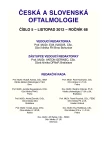-
Medical journals
- Career
Transnasal Endoscopic Surgery Approach in Intraorbital Tumors
Authors: Petr Matoušek 1,2; R. Lipina 2,3; Pavel Komínek 1; P. Šmehlík 3; T. Krejčí 3; J. Syrovátka 1; Karol Zeleník 1,2
Authors‘ workplace: ORL Klinika FN, Ostrava, přednosta doc. MUDr. Pavel Komínek, PhD., MBA 1; Lékařská Fakulta FN, Ostrava 2; Oční klinika FN, Ostrava, přednosta MUDr. Petr Mašek, CSc. 3; Neurochirurgická klinika FN, Ostrava, přednosta MUDr. Tomáš Paleček, PhD. 3
Published in: Čes. a slov. Oftal., 68, 2012, No. 5, p. 202-206
Category: Original Article
Overview
Objectives:
To determine the role of transnasal endoscopic approach to orbital lesionsMethods:
Retrospective case series.Results:
Three patients underwent endoscopic diagnostic surgery for orbital lesions. In all three patients was successfully finded out the diagnosis, the orbita was decompressed. In two cases it resulted to visual recovery, in one case was determine a diagnosis of metastatic adenocarcinoma. In one case the tumor was removed totally.Conclusion:
Using endoscopic approach to the orbit allowed good approach to the biopsy of orbital lesions, allowed decompression an in limited count of cases this access allowed a complete tumour removal. On the other hand, generally endoscopic approach is useful only for limited lesions (extraconal), usually it allowed only debunking, not the complete resection of orbital pathology.Key words:
orbital lesions, endoscopic approach
Sources
1. Tsirbas, A., Kazim, M., Close, L.: Endoscopic Approach to Orbital Apex Lesions. Ophthal Plast Reconstr Surg, 2005; 21(4): 271–275.
2. Stamm, A., Nogueira, JF.: Orbital cavernous hemangioma: Transnasal endoscopic management. Otolaryngol head Neck Surg, 2009; 141 : 794–795.
3. Abuzayed, B., Tanriover N., Gazioglu N., et al.: Endoscopic endonasal approach to the orbital apex and medial orbital wall: anatomic study and clinical applications. J Craniofac Surg, 2009; 20 : 1594–1600.
4. Otradovec, J.: Volba chirurgického přístupu k orbitálním expanzím. Cesk Oftalmol, 1983; 39(3): 194–7.
5. Otradovec, J.: Orbitologie. Cesk Oftalmol 1983,39(2): 94–9.
6. Šlapák, I.: Endonazální přístup k abscesu orbity u dětí. Otorinolaryng a Foniat /Prague/, 1997; 46(2): 118–122.
7. Šlapák, I.: Chirurgická léčba primárních tumorů orbity. Otorinolaryng a Foniat /Prague/; 2008, 57(4): 206–209.
8. Sethi, DS., Lau, DP.: Endoscopic management of orbital apex lesions. Am J Rhinol, 1997; 11 : 449–455.
9. Herman, P., Lot, G., Silhouette, B., et al.: Transnasal endoscopic removal of an orbital cavernoma. Ann Otol Rhinol Laryngál, 1999; 108 : 147–150.
10. Karaki, M., Kobayashi, R., Mori, N.: Removal of an orbital apex hemangioma using an endoscopic transethmoidal approach: technical note. Neurosurgery, 2006; 59(suppl 1): 159–160.
11. Yoshimura, K., Kubo, S., Yoneda, H., et al.: Removal of a cavernous hemangioma in the orbital apex via the endoscopic transnasal approach: a case report. Minim Invasive Neurosurg 2010, 53 : 77-79.
12. Castelnuovo, P., Dallan, I., Locatelli, D., et al.: Endoscopic transnasal intraorbital surgery: our experience with 16 cases. Eur Arch Otorhinolaryngol, 2012; 269 : 1929–1935.
Labels
Ophthalmology
Article was published inCzech and Slovak Ophthalmology

2012 Issue 5-
All articles in this issue
- Ranibizumab in the ARMD Wet Form Treatment – Two Years Results Obtained from the AMADEuS Registry
- Pars Plana Vitrectomy and Combination Therapy Pars Plana Vitrectomy, Intravitreal Triamcinolon Acetonid and Macular Lasercoagulation – One Year Results
- Clinical Variability of Best’s Disease
- The Current State of the Evidence of Malignant Tumors of the Eye and its Adnexa (dg. C69) in the Slovak Republic and in the Czech Republic
- Adjustable Versus Non-adjustable Sutures in Strabismus Surgery in Patients with Thyroid Ophthalmopathy
- The Application of Dysport® – the Possibilities of the Side Effect on the Eyelids Position (a Clinical – Histological study)
- Transnasal Endoscopic Surgery Approach in Intraorbital Tumors
- Czech and Slovak Ophthalmology
- Journal archive
- Current issue
- Online only
- About the journal
Most read in this issue- Clinical Variability of Best’s Disease
- The Application of Dysport® – the Possibilities of the Side Effect on the Eyelids Position (a Clinical – Histological study)
- Pars Plana Vitrectomy and Combination Therapy Pars Plana Vitrectomy, Intravitreal Triamcinolon Acetonid and Macular Lasercoagulation – One Year Results
- Adjustable Versus Non-adjustable Sutures in Strabismus Surgery in Patients with Thyroid Ophthalmopathy
Login#ADS_BOTTOM_SCRIPTS#Forgotten passwordEnter the email address that you registered with. We will send you instructions on how to set a new password.
- Career

